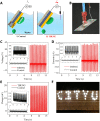Bubble energy generator
- PMID: 35749507
- PMCID: PMC9232101
- DOI: 10.1126/sciadv.abo7698
Bubble energy generator
Abstract
Bubbles have been extensively explored as energy carriers ranging from boiling heat transfer and targeted cancer diagnosis. Yet, despite notable progress, the kinetic energy inherent in small bubbles remains difficult to harvest. Here, we develop a transistor-inspired bubble energy generator for directly and efficiently harvesting energy from small bubbles. The key points lie in designing dielectric surface with high-density electric charges and tailored surface wettability as well as transistor-inspired electrode configuration. The synergy between these features facilitates fast bubble spreading and subsequent departure, transforms the initial liquid/solid interface into gas/solid interface under the gating of bubble, and yields an output at least one order of magnitude higher than existing studies. We also show that the output can be further enhanced through rapid bubble collapse at the air/liquid interface and multiple bubbles synchronization. We envision that our design will pave the way for small bubble-based energy harvesting in liquid media.
Figures




References
-
- Seymour R. S., Hetz S. K., The diving bell and the spider: The physical gill of Argyroneta aquatica. J. Exp. Biol. 214, 2175–2181 (2011). - PubMed
-
- Barthlott W., Schimmel T., Wiersch S., Koch K., Brede M., Barczewski M., Walheim S., Weis A., Kaltenmaier A., Leder A., The Salvinia paradox: Superhydrophobic surfaces with hydrophilic pins for air retention under water. Adv. Mater. 22, 2325–2328 (2010). - PubMed
-
- Jones T. J., Jambon Puillet E., Marthelot J., Brun P. T., Bubble casting soft robotics. Nature 599, 229–233 (2021). - PubMed
-
- Lohse D., Schmitz B., Versluis M., Snapping shrimp make flashing bubbles. Nature 413, 477–478 (2001). - PubMed
LinkOut - more resources
Full Text Sources

